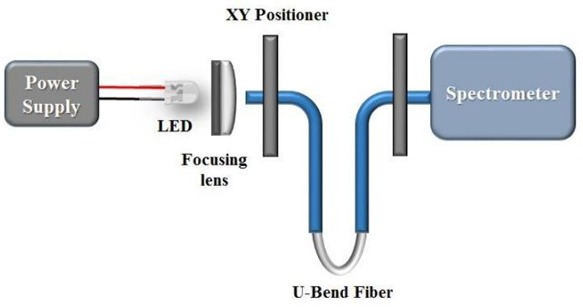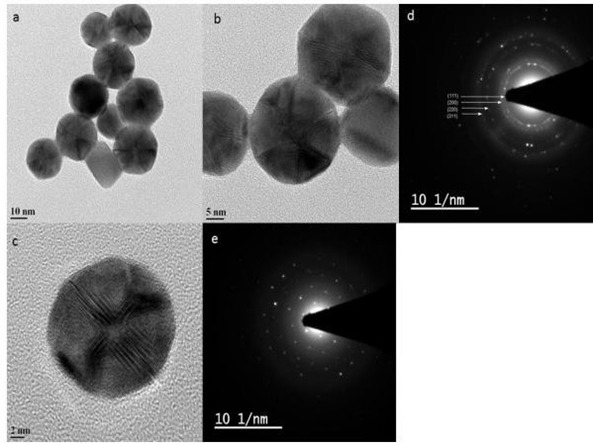Mercury is a diversely bioaccumulating heavy metal pollutant pernicious to all life forms. An optical biosensor has been developed and calibrated for universal detection and quantification of mercury contamination and exposure. Chitosan capped gold nanoparticles on bovine serum albumin were used as ultrasensitive mercury receptor on localized surface plasmon based U bend optical fiber platform. The sensor performance was evaluated by testing sewage contaminated water, marine water, long lived sea fish tissue, fossil fuel fly ash contaminated soil and vegetable samples. Experimentally determined limit of detection was 0.1 ppb Hg (II) in tap water (lesser than EPA limit of 2 ppb in drinking water) and 0.2 ppb in sea fish and vegetable samples. Recovery results were found in the range 85-110% of standard indicating good fitness for diverse usage.
Mercury is a highly toxic heavy metal that bioaccumulates in the environment, particularly in aquatic ecosystems, and poses significant health risks to humans through consumption of contaminated seafood, vegetables, and water. Current mercury detection methods, such as ICP-MS and atomic absorption spectroscopy, require sophisticated equipment, skilled operators, and extensive sample preparation. These methods are not suitable for on-site or field-based detection, leading to the need for a portable, cost-effective, and easy-to-use mercury detection system.
- Portable Optical Fiber Sensor: A U-bent silica core optical fiber functionalized with 3-(aminopropyl)triethoxysilane (APTES) and bovine serum albumin (BSA), with chitosan-capped gold nanoparticles immobilized for ultrasensitive mercury detection.
- Electrostatic Immobilization: Chitosan-capped gold nanoparticles are immobilized on the fiber using electrostatic interactions with BSA, optimizing selectivity and sensitivity to mercury.
- Localised Surface Plasmon Resonance (LSPR): The sensor detects mercury by monitoring changes in absorbance at the plasmonic peak of the gold nanoparticles, providing a real-time, direct detection method without the need for complex instrumentation.
- Low Detection Limit: The sensor can detect mercury at concentrations as low as 0.5 nM, significantly below the EPA limit of 10 nM, with high selectivity towards mercury ions.
- Portable and Field Deployable: The sensor is designed for field use, offering a simple, plug-and-play solution with disposable sensor cassettes, reducing the need for complex sample preparation or expert handling.
The prototype consists of a U-bent silica core optical fiber, with a diameter ranging from 50 μm to 1500 μm. The fiber is functionalized with APTES, followed by BSA immobilization using glutaraldehyde linkers. Chitosan-capped gold nanoparticles are electrostatically immobilized on the BSA-functionalized optical fiber. The sensor is coupled with a visible light source and a photodetector to monitor the change in absorbance at the plasmonic maximum of the gold nanoparticles for mercury detection.
This technology is at hypothesis testing, demonstration in lab stage.
4
The invention offers an affordable and scalable solution for mercury detection, making it accessible for environmental monitoring and food safety. It helps protect public health by detecting mercury contamination in water, soil, and food, reducing exposure to toxic levels. The sensor plays a vital role in environmental protection, efficiently monitoring mercury contamination in ecosystems and safeguarding wildlife and human health. Its field deployability allows for on-site detection without costly lab equipment, making it ideal for quick, easy detection in various settings.
- Environmental Monitoring: Mercury detection in water bodies, soil, and air for environmental protection
- Food Safety: Detection of mercury contamination in seafood, vegetables, and other food products for consumer safety
- Healthcare: Occupational exposure monitoring and detection of mercury in biological samples
- Water Quality Testing: Tap water, sewage, sea water, and other water sources for mercury contamination
- Agriculture: Detection of mercury contamination in soil and irrigation water
- Industrial and Mining: Monitoring of mercury pollution near coal-fired industries and mining sites
- Portable Testing Devices: Integration in consumer-facing portable devices for mercury detection
Geography of IP
Type of IP
201821043176
439462


